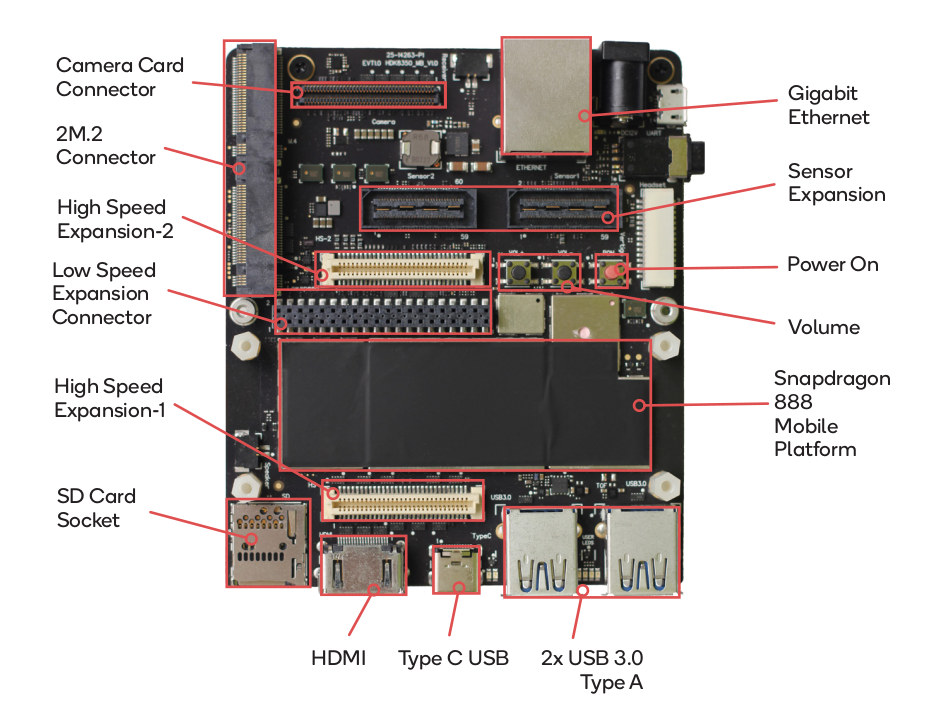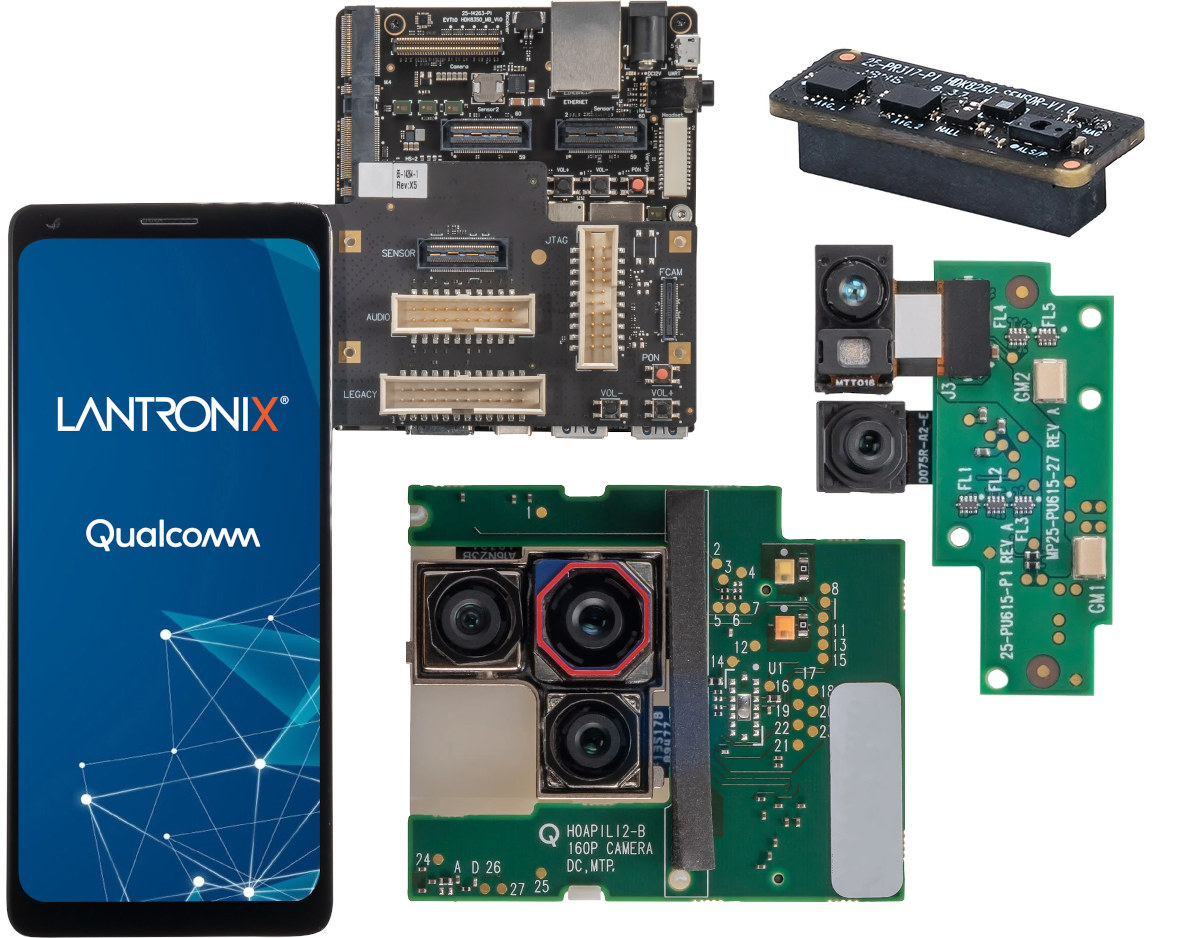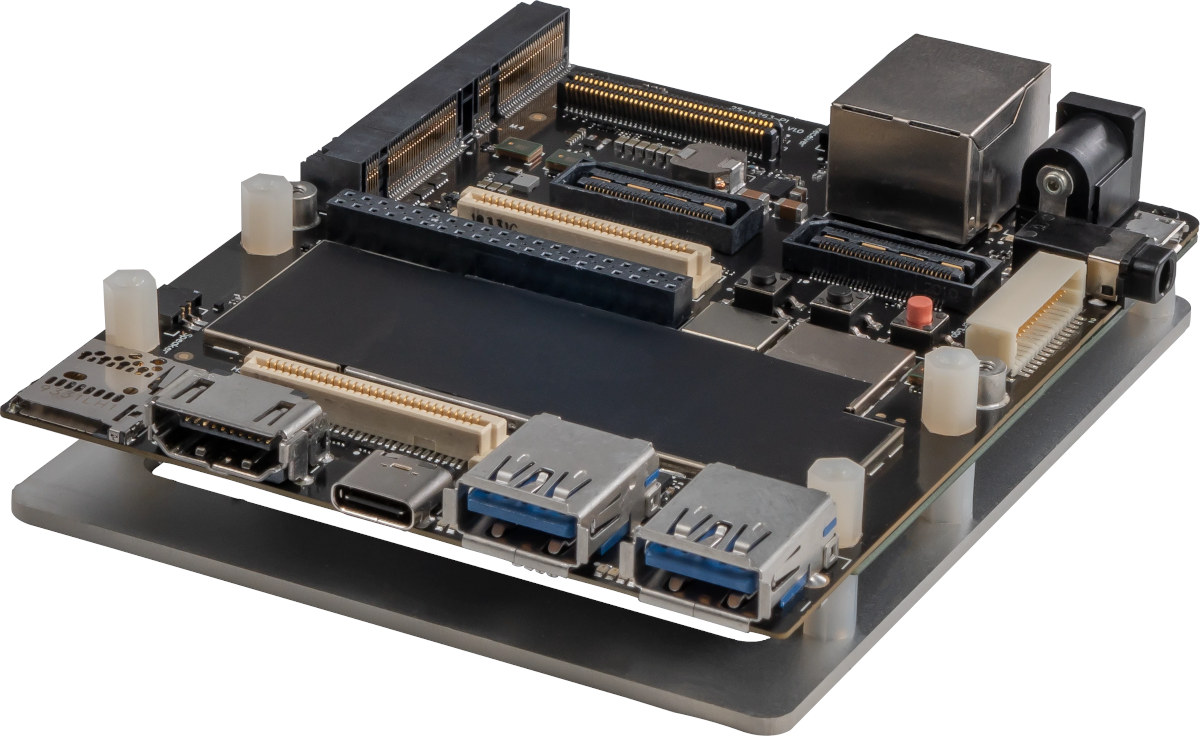Snapdragon 888 is the latest premium mobile SoC from Qualcomm with the octa-core processor combining one Cortex-X1 core, three Cortex-A78 cores, and four low-power Cortex-A55 cores, with Adreno 660 GPU and Snapdragon X60 5G modem.
The processor will likely most be found in smartphones, but Qualcomm partnered with Lantronix to launch the Snapdragon 888 Mobile Hardware Development Kit designed for Android app developers, hardware vendors, and original equipment manufacturers (OEMs).
Snapdragon 888 development board specifications:
- SoC – Qualcomm Snapdragon 888 (SM8350) octa-core Qualcomm Kryo 680 CPU with 1x Cortex-X1 core @ 2.84 GHz, 3x Cortex-A78 cores @ 2.42 GHz, and 4x Cortex-A55 cores @ 1.80 GHz, Adreno 660 GPU with support for OpenCL 2.0 FP, OpenGL ES 3.2, Vulkan 1.1, DX12, and up to 8K 360 VR video playback, Hexagon 780 DSP
- System Memory – 12GB LPDDR5 PoP memory
- Storage – 256GB UFS 3.0 flash, 1x MicroSD/UFS card
- Display
- HDMI 2.0 output up to 4K UHD
- DisplayPort 1.4 over USB3.1 Type-C
- 2x MIPI dual 4-lane DSI + touch panel interfaces
- Optional 6.65-inch AMOLED Display (2340 x 1080) with touch panel
- Audio – 3.5mm audio jack
- Camera
- 6x MIPI CSI with support for 3D camera configuration
- Optional rear camera daughter card with 16MP + 48MP + 13MP camera, VGA ToF sensor
- Optional front-facing camera accessory board with 20MP IMX476 front camera, MTT016 ToF camera
- Connectivity
- Gigabit Ethernet
- WiFi 6 – 802.11a/b/g/n/ac/ax @ 2.4/5GHz; Wi-Fi 6E-ready
- Bluetooth 5.1
- NFC
- USB – 1x USB 3.1 Type-C port, 2x USB 3.0 host ports, 1x micro USB 2.0 port for debugging
- Expansion
- 2x M.2 slots
- 96boards low-speed and high-speed I/O connectors
- 2x sensors expansion connectors
- Misc – Power and volume buttons
- Power Supply – 12V/5V via power barrel jack
- Dimensions – 100mm x 85mm (compatible with 96Boards CE Extended standard)
 The board supports Android 11, and can be used to develop high-end smart phones/tablets, mobile PC’s, smart IP cameras, artificial Intelligence gateways, or for application development. Note that there’s no mention of 5G cellular connectivity at all in the specs and product brief. Documentation should eventually become available on Intrinsyc’s projects page.
The board supports Android 11, and can be used to develop high-end smart phones/tablets, mobile PC’s, smart IP cameras, artificial Intelligence gateways, or for application development. Note that there’s no mention of 5G cellular connectivity at all in the specs and product brief. Documentation should eventually become available on Intrinsyc’s projects page.
By default Snapdragon 888 Mobile Hardware development kit ships with the Snapdragon 888 SBC, a 12V AC power adapter, a USB cable, and a setup guide. But many applications will benefit from the optional display board, and/or front and rear camera boards, all of which are showcased in the unboxing video below.
Since this is a low volume product aimed at developers and product designers, price is fairly high just like previous Lantronix/Intrinsyc hardware development kits. The base development kit is sold for $1,349, the display board adds $499, the rear and front-facing camera boards a further $299 each, and a sensor board with pressure hall, magnetometer, and accelerometer/gyro and additional $150. So if you were to purchase a complete kit, the total cost would be around $2,600 plus shipping and whatever taxes may have to be paid.
Additional information may be found on the product page.


Jean-Luc started CNX Software in 2010 as a part-time endeavor, before quitting his job as a software engineering manager, and starting to write daily news, and reviews full time later in 2011.
Support CNX Software! Donate via cryptocurrencies, become a Patron on Patreon, or purchase goods on Amazon or Aliexpress






I wish dev kits werent this exp
Hmmm X1+A78+A55 🙂 The next step probably is to connect a display, a keyboard and a charger to this and sell it as the next high-end laptop!
This will happen for sure since the Adreno 660 GPU supports DirectX 12. Major downside: Windows will be the only flawlessly working OS on such a hardware for years or maybe ever.
> Windows will be the only flawlessly working OS
Why ? lack of mainline support ?
Well, as mentioned few days ago better check what works and what not with those already existing Snapdragon laptops on Linux. Non functional Wi-Fi, BT and especially graphics acceleration IMO do not make up for an acceptable user experience.
Depending on GPU reverse engineering success maybe those Apple M1 thingies have better Linux support in a year or two compared to those Snapdragon ‘Always Connected’ laptops.
The reason this remains a mess is because ARM remains in the SoC world while x86 is in the CPU world. The difference is that you can hardly use an ARM-based SoC until you have the drivers for all devices included into it. In the x86 world, you just have the CPU and memory controller, you connect all your known-working devices via the PCIe bus and you can safely ignore manufacturers of bad stuff that requires reverse engineering. It would be nice if ARMs were going towards the PCIe mode, but sadly it’s rather the other way around these days.
And sadly, the relaxed use of the GPL that made Linux succeed everywhere by tolerating that vendors constantly stay on the border line with it is what might cause it to lose ground by lack of hardware support in the future, once all PCs finally rely on undocumented SoCs. This will remind us the bad old days of the Xircom PCMCIA network cards, S3 video cards, Nforce chipsets and ESS audio chips that were barely working but necessary to use your laptop :-/
Development boards like this do help.
postmarketOS has benefited mainlining select Android phones based on the SoC found in the Dragonboard 410c. https://wiki.postmarketos.org/wiki/Qualcomm_Snapdragon_410/412_(MSM8916)
Although their focus might have shifted to ‘Linux phones’ such as Librem 5 and PinePhone, I’m sure they’d welcome a dev board to play with if it could be crowdsourced on their behalf!
No uefi, every ARM boards needs a seperate Linux distro.
When the current SBCs don’t have enough power to work as a desktop replacement (even if they were 100% optimized) there’s not a lot of interest to even make it work. Especially when you need a new image for every shitty board that comes out.
But I think this will change once we see cheap boards with good specs. Something like the RK3588 with 4 A76 cores. (hopefully at 3 ghz) Just need something that’s powerful enough to work properly even with shoddy optimization to ignite a spark.
I think the expectation is that RK3588 will clock closer to 2.2 GHz. Definitely not 3 GHz. Still an exciting chip (if it comes out anytime soon).
It would be nice to see some boards packing Cortex-X1 and/or up to 16 cores. Apple’s ARM products might prod the industry to move in that direction. Even Intel is doing 16-core x86 hybrid (big+small cores) CPUs.
2.2Ghz? really? didn’t they learn anything?, S922 can be clocked at 2,4Ghz without issues and it’s 12nm lithography, if that’s true 2,2Ghz is way underclocked for its capacity, as it’s made on 8nm, which means that roughly can be clocked at 2,7-2,8Ghz without any issue, and thinking that CPU is intended to be used on devices that are actually not portable, I don’t see the logic on this.
Let me be clear that it’s a guess. Nobody knows for sure yet. I doubt you will see 3 GHz though.
Note that there’s no proportional relation between lithography and frequency, as wire resistance, capacity and current all decrease at the same time. A finer pitch allows to waste less power into heat, hence to keep the device cooler, and benefit from this saving to increase the voltage a little bit and get a little bit more margin to increase frequency. Just to give one example, the 45nm core2quad that was in my previous PC, which I could run at 4.2 GHz with a bit overvolting on the stock fan (except in summer), happened to run at the same frequency as the top frequency of the 14nm i7 8650u in my laptop for a few seconds before it throttles.
Pity there is no SBC with developer support around the more affordable Unisoc
Alldocube iPlay 40 tablet sells for $180
Specs:
CPU: Unisoc Tiger T618 Octa-Core
2x A75 @ 2.0Ghz + 6x A55 @1.8Ghz
GPU: ARM Mali G52 MP2
RAM: 8GB LPDDR4X
Display: 10.4″ IPS @ 2000×1200
Storage: 128GB + Micro SD
Battery: 6000 mAh
802.11 AC Wifi + BT 5.0
Android 10
> the total cost would be around $2,600
Who would have thought that Apple would be the one with low, low prices?!? This makes M1 look like a discount store item.
> Apple … M1
…CPU-wise being a lot faster compared to Snapdragon 888: https://browser.geekbench.com/v5/cpu/compare/6193434?baseline=5956783
GeekBench reports “ARM Qualcomm @ 1.80 GHz” for the Qualcomm processor. Could it be the single core benchmark was pegged to the little cores?
The problem with Apple processors is that you can’t do custom hardware, you just have to buy whatever hardware they provide. If they could sell their processor or at least provide a SoM with SDK, it would be relevant on CNX Software.
> Could it be the single core benchmark was pegged to the little cores?
An A55 at 1.8GHz is not able to exceed a 200 single-threaded score with Geekbench 5. It’s just Geekbench notoriously being bad at reporting real clockspeeds. In this case I would assume the four A55 are cpu0-cpu3 and they choose cpu0 to report sysfs’ cpuinfo_max_freq.
The reported single-threaded GB5 score for the Cortex-X1 is comparable to an i7-7700K at 4.2GHz.
Dev kits are always expensive; they’re not consumer items.
until arduino came along. always? i think its really about market expectations.